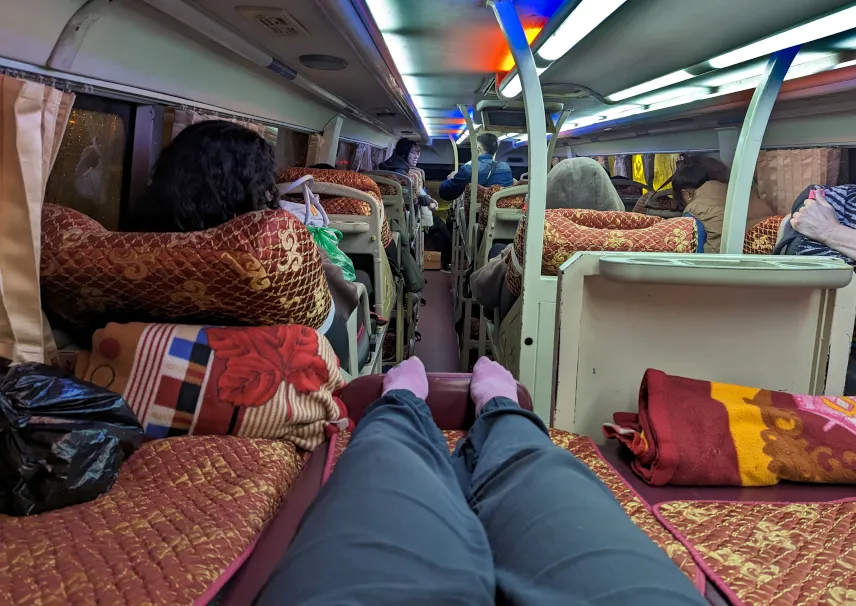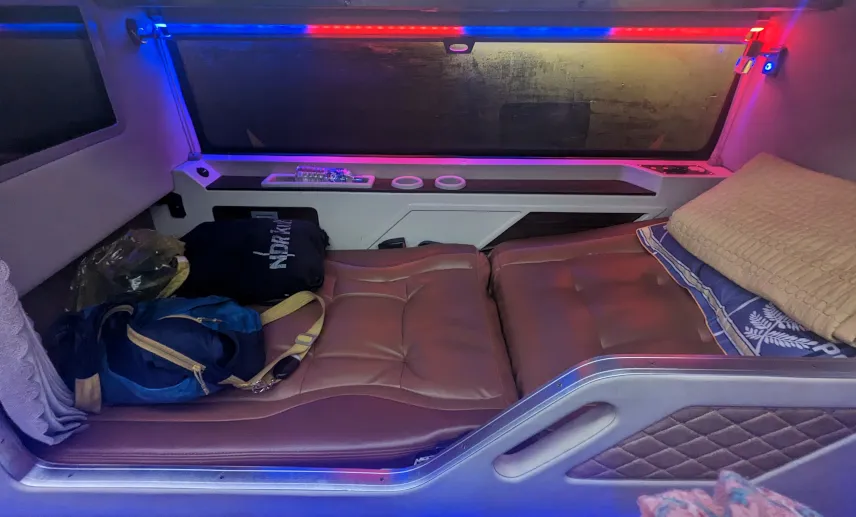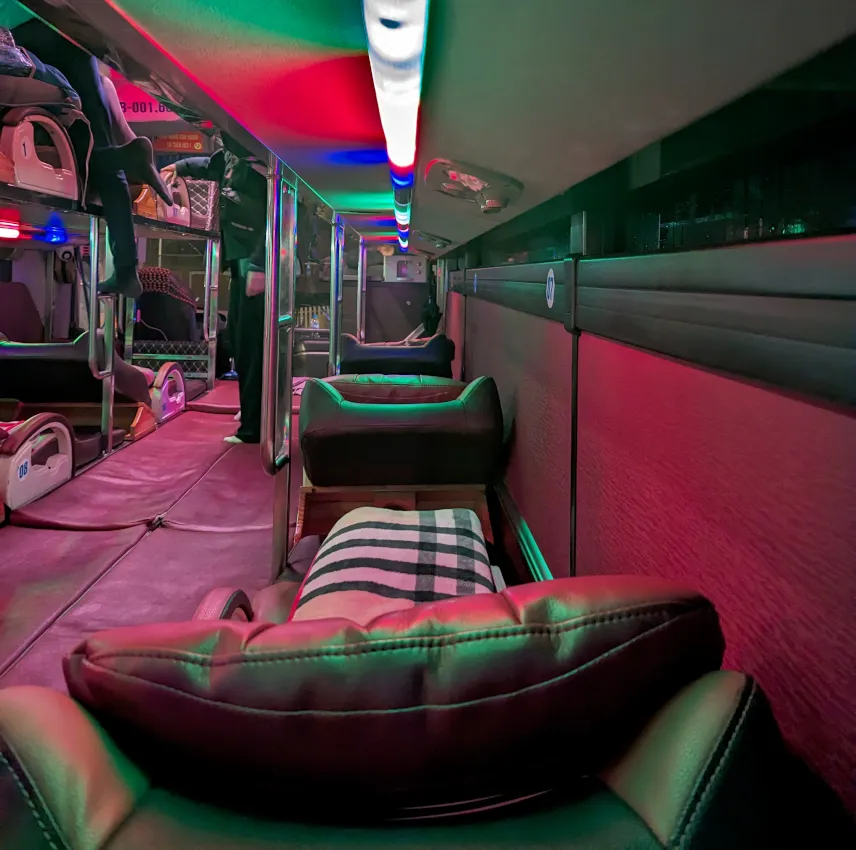
Vietnam Sleeper Buses – Our Experiences
TL;DR
We took what feels lime a million sleeper buses in Vietnam. This is our survival guide and review.
For environmental reasons, we avoid flying as much as possible when we travel. We even went from Hanoi to Singapore without taking a single flight. That meant taking loads of night buses in Vietnam.
This is why we have created this travel guide on Vietnamese sleeper buses. We’ll give you our personal review at the end. Spoiler: We are fans!
- Sleeper Buses in Vietnam – Travel Guide
- Sleeper Buses in Vietnam – FAQ
- Do Vietnam Sleeper Buses Have Bathrooms?
- Do Sleeper Buses in Vietnam Have WiFi?
- Can You Charge Your Phone on a Vietnamese Sleeper Bus?
- Can You Eat on the Sleeper Bus?
- Do the Sleeper Buses Stop for Breaks?
- Are Sleeper Buses in Vietnam Safe?
- Solo Female Travel on Vietnamese Sleeper Buses
- Are Sleeper Buses Comfortable?
- How Much Luggage Can You Take on a Sleeper Bus?
- What to Bring on a Sleeper Bus
- Is it Better to Use the Bus or Train in Vietnam?
- Sleeper Buses in Vietnam – Our Personal Experiences
Sleeper Buses in Vietnam – Travel Guide
What Is a Sleeping Bus in Vietnam?
To this date, we have taken sleeper buses on four different continents in many countries, and let us tell you, the Vietnamese ones are our favourites.
If you’ve ever taken a Flixbus in Europe over a long distance, you might not be very eager to repeat this experience. Even the “Greyhound Luxury Dreamliner” in the USA seems to pale compared to the average Vietnamese sleeper bus.
Here’s why:
- They are cheap.
- They connect all the important destinations.
- Their seats are super comfy (depending on the class you book, seats recline partly or even fully, some even have little private capsules).
How Much Is a Sleeper Bus in Vietnam?
Sleeper buses in Vietnam are crazily affordable. For the 7-hour ride from Hanoi to Ha Giang, ticket prices start at around 10$. A VIP bus with a private capsule will set you back around 20$.
How to Book a Sleeper Bus in Vietnam
You have three main options for booking sleeper buses in Vietnam:
- A travel agency
- Your accommodation
- Online
What is the Best Website to Book a Bus Ticket in Vietnam?
The website we use to book our bus tickets in Vietnam (and many other countries) is 12Go:
Different Types of Sleeper Buses in Vietnam
We felt like there were a million different types of buses from ones with regular seats to ones with private capsules. Most buses have bunk beds with a lower and an upper bunk.
The cheapest configuration seems to feature three bunk beds per row. The seats are reclined a lot but not fully.

The most luxurious configuration is VIP with private capsules. Here, the seats are fully reclined beds.

We also encountered this configuration with two rows of proper beds and a row of mattresses on the floor (which are also used). Overall, we had the feeling, that Vietnamese overnight buses are like a box of chocolates.

Seats on a Sleeper Bus
The seats on the buses are not assigned. One pattern seems to be that tourists get grouped in the back (we heard the rumour that it’s for security reasons).
Also, in our experience, it was always the locals who ended up on the floor mattresses.
We could always sit next to each other and were never uncomfortably close to strangers.
As an average-sized woman, I found the seats quite spacious and I could even lie flat in the VIP capsule bus. If you’re tall, that might not be the case.
Sleeper Buses in Vietnam – FAQ
Do Vietnam Sleeper Buses Have Bathrooms?
The answer to “Do sleeper buses in Vietnam have toilets?” (like many others in our FAQ) is it depends.
Around one quarter of the buses we took had toilets so I would absolutely not rely on them. All buses stopped for breaks though – whether they had a toilet or not.
Do Sleeper Buses in Vietnam Have WiFi?
The limousine and VIP buses claim that they have WiFi but to be transparent, it never worked for us.
Can You Charge Your Phone on a Vietnamese Sleeper Bus?
The limousine and VIP buses come with charging ports. Sometimes they worked for us, sometimes they didn’t so I would not rely on your ability to charge your phone on the bus.
Can You Eat on the Sleeper Bus?
You can’t buy any food on the long-distance buses so we recommend eating before and bringing your own snacks. Some people even brought proper meals on the bus and there were no complaints.
We got free water on some of the VIP buses but again, that’s nothing we would rely on. We recommend bringing enough water for the ride to be safe.
Do the Sleeper Buses Stop for Breaks?
All buses we took stopped for breaks to use the toilet and buy food and drinks.
Are Sleeper Buses in Vietnam Safe?
Statistically, Vietnamese sleeper buses are safe. They cruise up and down the country every day and you rarely hear about any incidents. Of course, accidents can always happen on the road – be it in Vietnam, Germany, or the USA…
We always felt safe on the buses. Our drivers seemed to drive carefully enough but sometimes you hear stories from other travellers whose drivers seem to have been wannabe race car drivers.
There are some rare stories about theft so we decided to rather be safe than sorry and kept our valuables super close to our bodies at all times (while you go to the toilet, rest stop, sleep) – honestly we’re fans of the fanny pack/bum bag for this – and we never had any issues.
Solo Female Travel on Vietnamese Sleeper Buses
I took Vietnamese overnight buses as a solo female traveller and felt perfectly safe.
Are Sleeper Buses Comfortable?
As a 1.66 m (5' 5) woman, I found the sleeper buses in Vietnam very comfortable. If you’re a 1.90 m (6' 2) man like Philipp, you might have a different story to tell.
Seats were generally wide enough for us and long enough for me.
How Much Luggage Can You Take on a Sleeper Bus?
Again, this depends on the company. Most companies allow for up to 20 kg (44 pounds) so you should be fine with your average-sized backpack or suitcase. We never saw any weight checks or anyone being rejected.
Your big back gets stored in the luggage compartment under the bus. We strongly recommend to bring a small backpack on the bus with you for your valuables and necessities.
What to Bring on a Sleeper Bus
Speaking of necessities. Here’s what we recommend to bring on a sleeper bus:
- Earplugs and a sleep mask (some form of light will stay on during the night)
- Water & snacks
- Toilet paper
- Disinfectant
- Entertainment (some buses have screens but we never managed to get any form of – English – entertainment going)
- Layers – we mostly got a pillow and a blanket but again, we would not rely on it
- Cash for the rest stops
- Travel sickness pills if you might think you need them (personally, we did fine without them)
Is it Better to Use the Bus or Train in Vietnam?
Spoiler: In Vietnam, we prefer sleeper buses to sleeper trains.
Sleeper Bus |
Sleeper Train |
|
More stations in locations which are more convenient for tourists (e.g. Hoi An, Tam Coc) |
Stations in bigger cities (e.g. Da Nang instead of Hoi An, Ninh Binh instead of Tam Coc) |
|
Cheaper |
More expensive |
|
Faster |
Slower |
|
Views are limited (but it’s mostly dark anyway) |
Better views (but it’s mostly dark anyway) |
|
Easier to book last minute |
Can book out fast (depending on your seat of choice) |
|
Felt cleaner |
Blankets can be used + we had a little cockroach friend in our bed |
|
Can’t get into a car accident |
Here’s our full sleeper train review:
Sleeper Buses in Vietnam – Our Personal Experiences
As you might have guessed, we are big fans of the Vietnamese sleeper buses.
From the moment, we took our shoes off at the door, we felt snug as a bug. The buses felt clean, the seats were comfortable and the drivers we had weren’t too wild – we slept like babies.
We also took enough rest stops to buy more snacks and drinks and use the toilet.
All in all, sleeper buses are a super convenient and affordable way to explore Vietnam. Try them at least once to form your own opinion and let us know what you think in the comments!
This post contains affiliate links. If you use these links to buy something we may earn a commission. You would help us a lot if you do so. Thanks.

